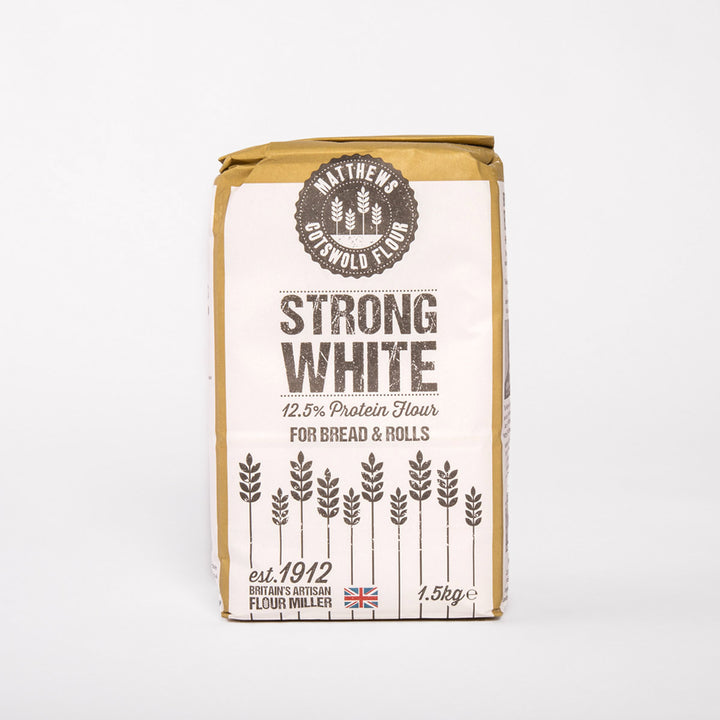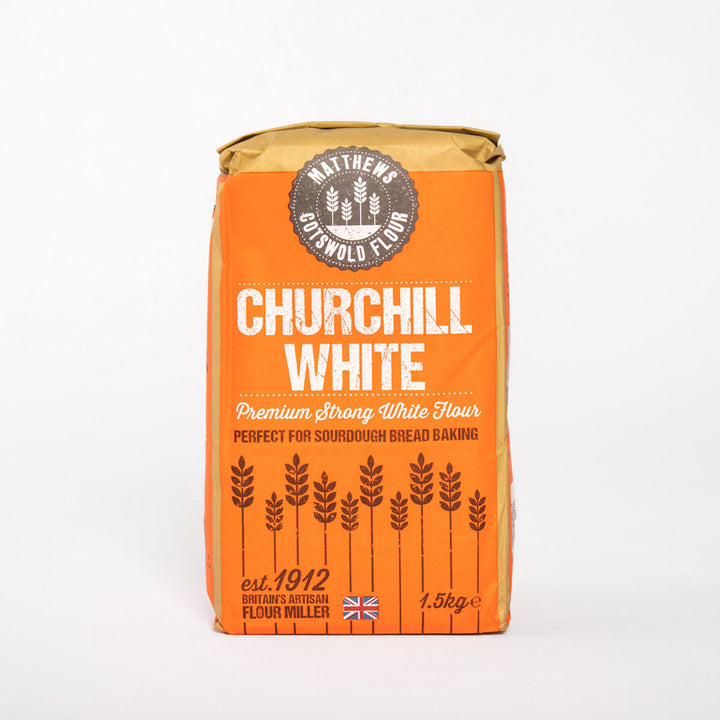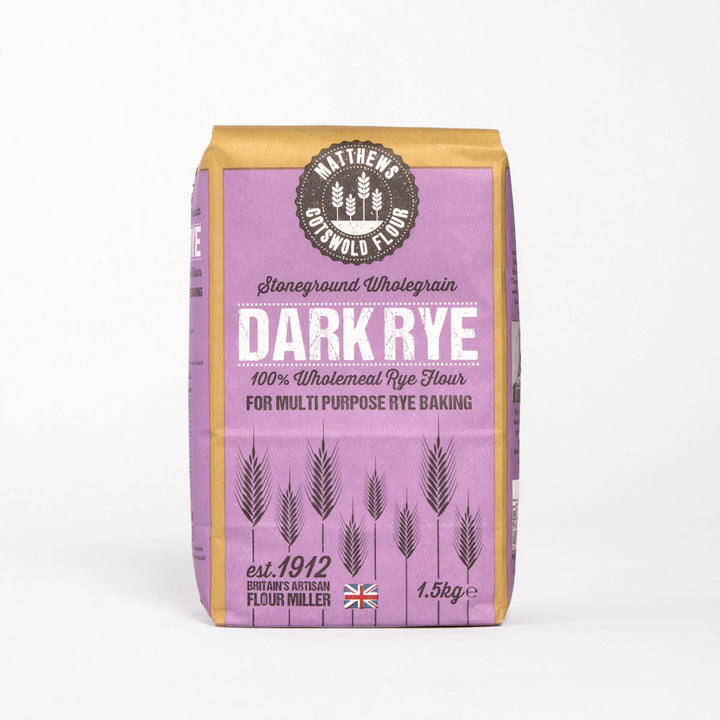Elaine Boddy's Guide To Your New Sourdough Starter
Welcome to this most wonderful world of sourdough and the starting point to making your very own amazing bread. Here you are going to find everything you need to know to get started and to go on to making your first loaves and beyond.

Sourdough Starter Step-by-Step
If you’ve ever thought that making sourdough seemed complicated or scary, or you’d need a degree in all of the sciences to make it, or that you’d need to use water blessed by angels… let me tell you now: none of that is true. Making sourdough is so much simpler than we have been lead to believe, and that is what you will find here. No percentages, no ratios, no unnecessary steps, and definitely no lost sleep, just life friendly, simple steps.
It all begins here...
Before We Begin…
‘There’s more nonsense talked about sourdough than any other foodie subject - so it’s not surprising many cooks are put off, thinking it’s complicated, or time-consuming, or that they are signing up to some eternal commitment. If you’re interested in sourdough, Elaine has a
gift for explaining things in plain English, showing you what to expect and organising recipes so that they fit in with your life, rather than the other way round. I defy anyone not to produce a decent sourdough using her master recipe, and once you’ve done that, Elaine has done all the experimenting so you can get creative with different grains and techniques. Bread bakers everywhere - here’s the person you’ve been waiting for.’
Orlando Murrin - President, Guild of Food Writers
Our Sourdough Guru
Elaine Boddy is the author of three fantastic Sourdough recipe books, prolific blogger, celebrated speaker and Foodbod podcast presenter. Elaine has worked with Cotswold Flours for years, but has only recently joined us as our new Sourdough Brand Ambassador. Find out more about Elaine now.
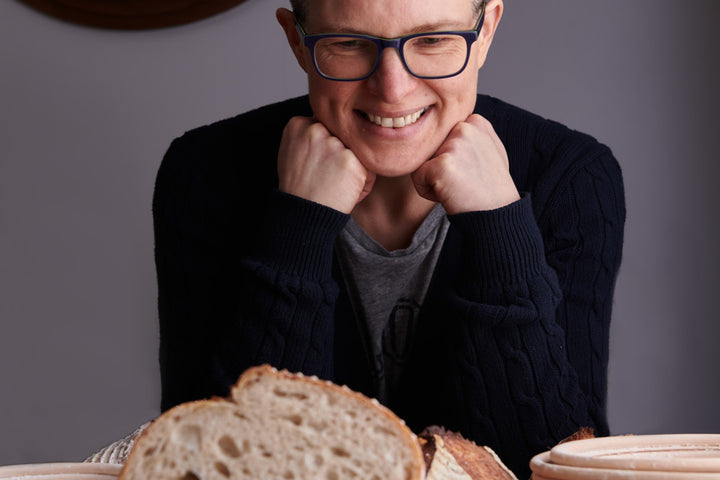
Elaine's Sourdough Starter Top 10 Tips
1. Use good flour.
I know you’re here on a flour millers' website, but that’s not why this is top of my list... It’s because it really does make a difference. When I first started making sourdough I thought ‘flour’ was just ‘flour’. I learned very quickly that not all flours are created equal. The flours we choose have an impact on our sourdough making.
You can use any wheat flour to make a starter. As a learner, I would highly recommend using strong white bread flour or wholewheat/wholemeal flour, but I would also branch out into other flours. The beauty for you is that I have made starters with a LOT of the Cotswold Flour range so I can give you first hand tips on how they are likely to behave.
2. Water.
The water used in a starter can also make a difference to how it behaves. Distilled or reverse oxygen water can sometimes hamper the growth of a starter.
Where I live, and in most places in the UK, using tap water is fine. But ,if you’re not sure, try boiling and cooling your tap water. If your tap water smells strongly of chlorine, fill a jug and leave it to sit out for 24 hours, the chlorine will evapourate off.
If you have a jug with a lid, you can prepare a jug of water ready to use for the week.
3. Use scales.
When I was first introduced to making sourdough, the quantities were in cups; as soon as I switched to using scales and carefully weighing the flour and water, it dramatically improved the performance of my starter. I use Salter digital scales.
4. Keep it small.
I only ever use small quantities for making and maintaining my starters, and that’s all you need to do. This not only means that you’re efficient with the amounts of flour used, but it also keeps your starter lean and healthy. In this instance, less is definitely more.
5. Give it time.
Another key lesson sourdough teaches is that patience is not merely a virtue, but a requirement. There is a joy in the slow pace of sourdough, but it can also worry new sourdough makers, do let it happen though, it will be worth it.
And do keep in mind that new starters don’t work to a clock, they will be ready when they’re ready. Some are ready in 7 days, some take 3 weeks, there isn’t a fixed or standard amount of time. If yours isn’t ready to use in 7 days, it’s fine, keep following the steps and let it happen.
There are some ways that you can encourage it along that I’ll share along the way, but patience is truly the key.
6. Be consistent.
When you find what works for you, stick with it. Especially if you're new to sourdough, stick to a process, once you feel more confident, by all means experiment, but build up to that.
7. Resist diving into rabbit holes.
If you’re new, don’t read too much. You can easily get overwhelmed with a flood of information. Choose a single source and stick with it whilst you learn how sourdough works. Which is why I’m here, to provide you with everything you need to know.
8. Starters rarely die.
People often don’t realise that starters are very resilient, they are rarely dead unless they get mouldy. If there’s pink or orange mould, it’s not a good sign, but that really is rare.
9. Starters don't need to be babysat.
Starters don’t need constant tending, or feeding for the sake of it, once your starter has been made and established, you only ever need to feed it to use it. It doesn’t matter if you use it once a
week, once a fortnight or once a month. It will survive in the fridge when you go on holiday, no one needs to come and tend to it. And never assume you need to chuck it out and start again, starters can always be tended back to health, unless, as aforementioned, they get mouldy.
10. Seriously - use good flour.
As a final tip, if you can, choose the best quality flour possible for your starter at least. It truly does make all the difference and is worth the investment.
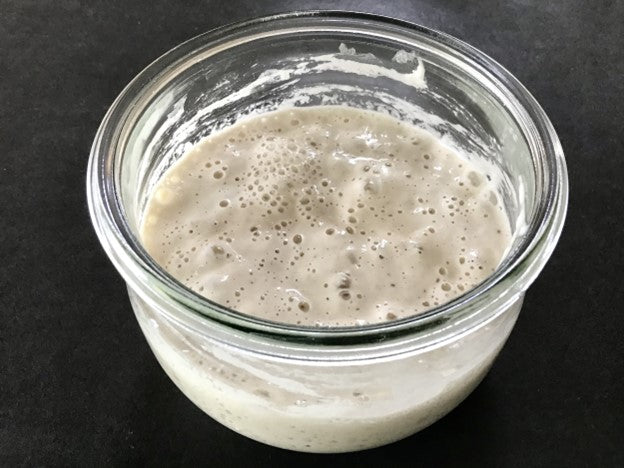
Sourdough Starter: Truly Simple To Make & Use
Flour and water, that’s all it is, flour, water and time. But, what makes a real difference to a starter, is the flour that you make it with; different flours create different looking and behaving sourdough starters, with distinct flavours and textures. And the beauty of being here, as part of the Cotswold Flour family for me, is that I can reference exact flours for you as they are the exact flours that I use in my kitchen.
Pictured: a strong white starter.
What is sourdough starter?
Sourdough starter is where it all begins, it is the starting point for our sourdough creations, it’s what lifts our loaves, and gives sourdough its texture and flavour.
The key difference between a starter and other bread raising agents is that starter is in liquid form and lives in our fridge and with the right care and use, lasts forever.

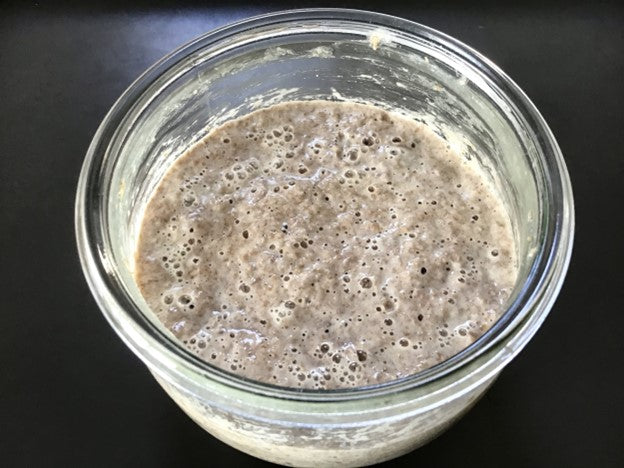
Whole Grain Sourdough Starter
This is an example of a wholemeal sourdough starter. Wholewheat sourdough starters are full of texture and flavour. They can lead to a more flavoursome and sometimes more sour loaf of bread. As starters they grow wonderfully. You can see the full texture in them all the way up the side of the jar! (See image).
How To Make A Sourdough Starter
A sourdough starter is basically fermented flour and water; by mixing them together, allowing them time to ferment, managing how much we keep, and watching the consistency, we can easily create a happy working successful starter.
What You Need:
- Digital scales
- A clean container, preferably a glass bowl or jar with fitted lid, around 600ml. Glass doesn’t hold aromas or become impregnated by previous ingredients and is perfect to use. I use a 580ml Weck 744 tulip jar or a Weck 742 jar.
- Good quality strong white bread flour or strong wholemeal flour. I use recommend Cotswold Flour strong white bread flour, or stoneground wholegrain flour. Other good options are the organic strong white flour, or the organic stoneground wholegrain flour.
- I will refer to other flour options later.
- Water, as above.
- A clean stainless steel spoon for stirring.
Top—TOP—Tip:
Whatever utensils you use to make sourdough, whether it’s a stainless steel spoon, jars, mixing bowls, always soak them in COLD water as soon as you have finished using them. Sourdough dries like concrete on anything it touches and hot water cooks it on, even in a dishwasher.
And if you ever choose to discard starter, don’t throw it down the sink for the same reasons, put it into your food waste bin or add it to your compost heap - but best advice is, use it! With my processes you don’t build up much discarded starter, but if you do collect any, use it to make pancakes or flatbreads or add to cakes. You can find various such recipes in my books.
Actions:
Each step represents a single daily action, this can be done at any time of the day; after each one, stir the mixture well, scraping down the sides of the container, and mix it all in, then loosely cover the pot again and leave it on the counter.
On the days you are asked to remove half of the contents, do so by eye and collect the discarded starter in a bowl and use it to make pancakes or other recipes.
Whilst making a starter, always sit the lid on your jar so that it is well covered, but not wholly firmly pressed closed; as part of the fermentation process your starter will release gasses which need to
be able to escape. This also explains why the underside of the lid can often be damp, this is all normal.

Shop Sourdough Flours
Matthews Cotswold Flour has the largest range of specialist flours in the UK, so you'll always be able to find what you need to make amazing sourdough every time! Checkout Elaine's recommendations for great sourdough with the link below!
Elaine's Super Sourdough Starter Method
Day 1:
In your container, mix 50 grams of flour with 50 grams of water. Stir them together well, it will be nicely thick, even thicker if you are using the wholegrain flour option but don’t be tempted to add any extra water. Place the lid loosely on your jar, and leave on the kitchen counter. If using a Weck jar just sit the glass lid on top of the jar with no clips or rubber seal.
Day 2:
Add 30 grams of your flour and 30 grams of water, stir it well, scrape the jar down, and replace the lid loosely. Leave it on the kitchen counter. The mixture will be stretchy. If you are using wholegrain flour it may have formed a stretchy dough like paste.
**Bubbles may start to appear on day 2-4 and it may start to smell eggy or cheesy, or wheaty and sour if using wholegrain flour. This is normal.
Day 3:
Add 30 grams of your flour and 30 grams of water, stir it well, scrape the jar down, and replace the lid loosely. Leave it on the kitchen counter.
**If your starter begins to grow a lot and you’re concerned it will outgrow the jar, stir it down. This won’t harm the starter or affect its growth, but it may protect your counter!
Day 4:
Your starter may now be smelling vinegary; that is all normal, it shows that the process is happening. Remove half of the starter and put it into any jar or pot, and put it into the fridge.
Add 30 grams of your flour and 30 grams of water to the remaining starter, stir it well, scrape the jar down, and replace the lid loosely. Leave it on the kitchen counter.
Day 5:
If your starter is now looking less active and bubbly, do not be disheartened; it is all part of the process. Stick with it and keep building the strength in your starter.
Add 30 grams of your flour and 30 grams of water, stir it well, scrape the jar down, and replace the lid loosely. Leave it on the kitchen counter.
Day 6:
Remove half of the contents of the jar again, add it to the starter you collected on day 4. Add 30 grams of your flour and 30 grams of water, stir it well, scrape the jar down, and replace the lid loosely. Leave it on the kitchen counter.
Day 7:
Hopefully, you are now seeing bubbles all the way through the mixture and it responds and grows after each feed. White flour starters can look really exciting now, bubbly and even volcanic. Wholemeal flour starters will be more textured up the sides, with an undulating surface. This is another reason that it’s good to use jars or glass pots for your starter because you can see the growth up the sides of the jar.
Add 30 grams of your flour and 30 grams of water, stir it well, scrape the jar down, and replace the lid loosely. Leave it on the kitchen counter.
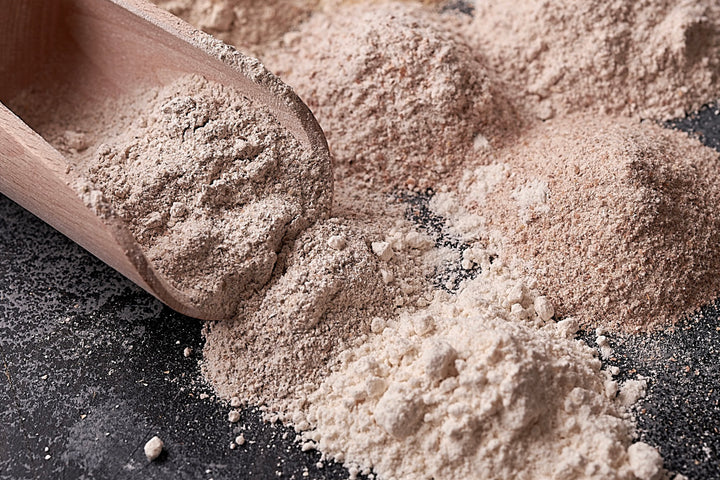
Ancient Grain Flours in Sourdough
Ancient grain flours can help you make some truly spectacular sourdough, but there are a few things you need to know before you start. Check out Elaine's top tips for making Ancient Grain Sourdough now.
Sourdough Starter Frequently Asked Questions & Notes
Note:
If your starter becomes thin at any point, it needs to be thickened up again. A thin starter is a weak starter. If this happens, feed it with 30g flour and 15g water to return it to its optimum thickness, it needs to feel like a stirrable thick paste when you feed it. It needs to feel like a thick pancake batter or wallpaper paste once it has had time to grow.
Repeat this action if the starter keeps becoming thin. If this is happening it may be because the starter is becoming too warm. Starters typically become thin if the flour is weak, or they are being kept too warm, resist the temptation to leave them in warm spaces for hours and hours. Some warmth is nice, too much will weaken your starter. If you have an Aga, move your starter away from it.
If your starter develops a murky, watery surface, it is not ruined, it is just telling you that it is hungry; it has over fermented and ‘split’, it will also smell strongly. In this case, stir it back together, feed it and continue, if it feels thin add extra flour.
Is my starter ready to use?
Your starter is ready to use as soon as it routinely grows several hours after being fed, if this has happened on day 5, 6 and 7, it’s ready to use.
If you are not sure whether it is ready by day 7, repeat the same process from Day 4 onwards until this happens. You are looking for your starter to grow, possibly double in size to know that it’s working. If you are not sure, take photos for reference.
Once it is ready, keep the lid firmly shut tight, if you’re using a Weck jar, put the clips in place, the seal is not needed, and store it in the fridge until you are ready to use it. From this point on, you no longer need to keep discarding and feeding; when you are going to use it, only ever feed it for making your dough.
How much starter should I have?
Aim to keep between 50-100g of starter at any time, you do not need any more than that. If you have built up a greater amount, remove some, use it in a recipe, and reduce how much you’ve got. Remember, less is more. All you need is that small amount to create the hundreds of sourdough loaves you can now make.
Sourdough Starter FAQ
Q: Help - I forgot to do/missed day 4 - is my sourdough starter ruined?
A: No, it’s fine, just carry on where you left off.
Q: My sourdough starter isn’t bubbly like yours, it something wrong with it?
A: No, all starters look different and different flours and water produce different outcomes. Starters do not need to be bubbly, they just need to grow a few hours after they’ve been fed, that shows that they are working.
Q: I added 35g of flour instead of 30g, what should I do?
A: Add 35g water to even it out.
Q: My starter smells so bad it’s taking over my whole kitchen... What should I do?
A: Keep going, this is normal and it will pass.
Q: My starter has teeny tiny bubbles on the surface and isn’t growing... What's gone wrong?
A: Teeny tiny bubbles usually occur if the starter is also thin, which means it’s also weak. See our Starter Guide for more info.
Q: I’m on day 15 and nothing is happening... Is my sourdough starter dead?
A: No, keep going, always keep going.
Q: Is it ruined? Is it dead? Should I throw it out and start again?
A: These are the questions I am asked the most. I find that people often assume their starters are dead, and can be too ready to throw them away. This is such a shame. 99% of the time it's totally unnecessary. Sourdough starters are far more resilient than people realise, and are actually quite hard to kill. If in doubt, always persevere.

